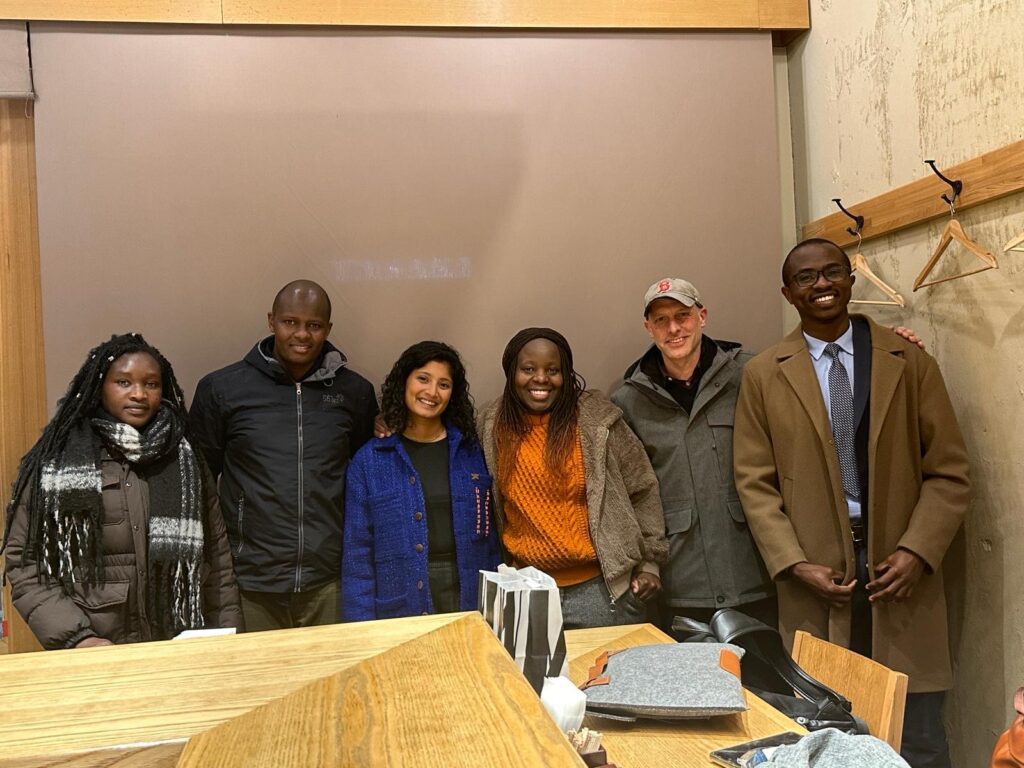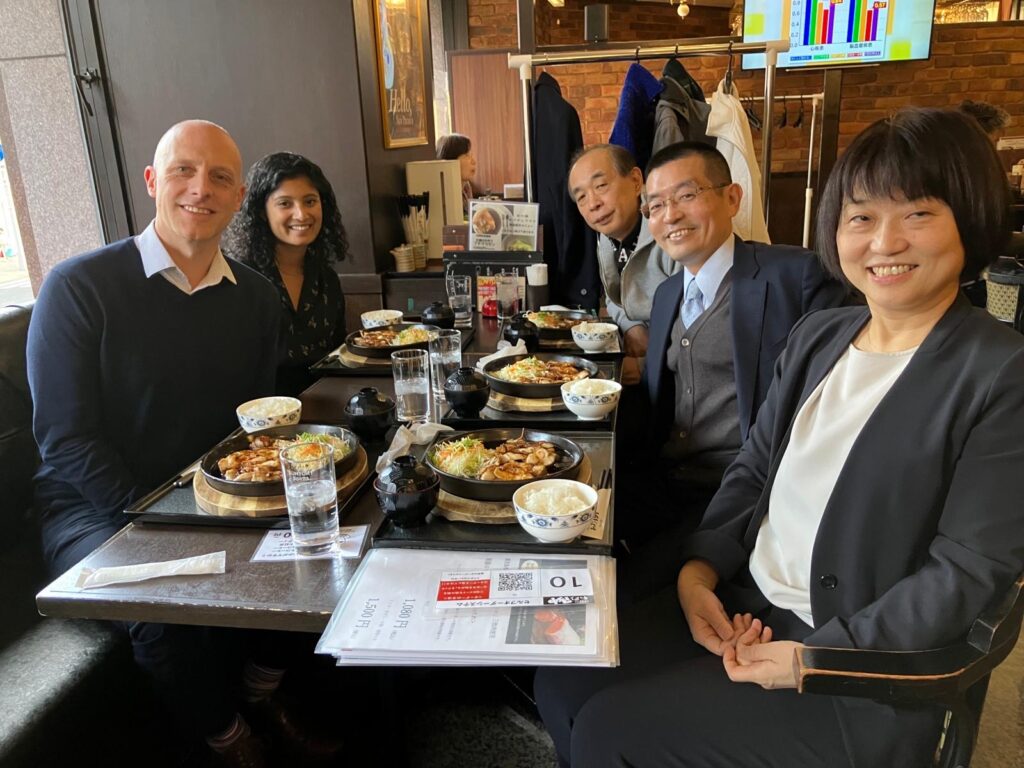LaMP visited Japan earlier this year to develop a deeper understanding of its labor migration system. We are now developing a pilot to provide opportunities for Kenyan workers in Japan, focusing on trade and services sectors (mechanics, manufacturing, construction, elderly care, hospitality, etc.) Please reach out if you are interested in learning more about the pilot program or want to learn more about Japan’s migration system!
FAVORITE QUOTE
- “Japan is competing with the rest of the world to win the global war of talent” – Official, Japanese government
- “We need to promote our workers in Japan, just like we do our tourism and the caliber of our runners” Official, Kenyan government

LaMP team met for a dinner with Kenyan diaspora to understand worker perspectives and experiences with cultural integration.
DESTINATION JAPAN
The LaMP team traveled to Japan to meet with stakeholders across the public and private spectrum including employers, government, funders and foundations, Japanese International Cooperation Agency (JICA), recruiters, language schools, researchers, diaspora, and diplomatic representatives.
The objectives of the trip were threefold:
- Understand the Japanese landscape for labor mobility and build strategic partnerships;
- Develop the design of a mobility project to send workers from Kenya to Japan while exploring initiatives to scale movement of workers between Bangladesh to Japan
- Meet with diaspora from Kenya and Bangladesh to understand employment opportunities and integration. The team’s trip coincidentally aligned with Kenyan President Ruto’s visit to Japan and LaMP had the privilege of joining a diaspora event for Kenyans in Japan held by the President’s office.
Labor mobility is a priority for Japan as the country faces a growing worker shortage that will reach 3.4 million by 2030. These labor shortages are primarily caused by aging of the Japanese population (Japan has a median age of 49). As one solution to this problem, Japan has created two key migration programs – Technical Intern Training Program (TITP) and Specified Skilled Worker (SSW) – that offer foreign-born workers employment in Japan across shortage sectors including but not limited to auto-repair and maintenance, manufacturing, construction, agriculture, nursing, hospitality and building cleaning.
Despite these acute labor shortages, the LaMP team and partners have found it challenging to convince individual actors – especially small and medium enterprises (SMEs) or those servicing SMEs – to hire workers from a new sending country such as Kenya and Bangladesh. Employers remain cautious of being the “first mover” by employing workers from new source countries versus workers coming through historically established routes, such as the Philippines and Vietnam. However, Southeast Asian countries are slowly experiencing declining birth rates. On top of that, we learned anecdotally that Southeast Asian migrant workers find it more attractive to work in countries with more competitive wages and better economic prospects, such as the USA or South Korea, rather than Japan.
However, LaMP’s conversations with members of the Japanese government, particularly the Ministry of Justice responsible for the strategic design of Japan’s migration program, demonstrated commitment to building a strong and reliable system for international workers in Japan, and recognition of labor migration as a win-win for both the sending and receiving countries. Japan’s labor migration system was revised in February 2024 to make it easier for workers to work and live in the country over the long-term by developing a pathway system allowing extensions and conversions of visas for a period of 3-8 years. The changes will go into effect in 2027. Efforts by JICA including the “Japan Platform for Migrant Workers Towards Responsible and Inclusive Society” – or JP-MIRAI – have led to increased transparency and worker protection in the labor migration system.
Some large corporations in the mobility business in Japan are increasingly recognizing the need to diversify their source countries for labor. Labor Mobility Partnerships (LaMP) is working with these actors to open up new migration pathways to Kenya and Bangladesh. This comes with its own set of challenges including language, bureaucracy, and cultural nuances – all while building a new migration pathway. LaMP is currently working on developing a pilot mobility program between Kenya and Japan by bringing together relevant actors, such as recruiters, employers, training institutes and government to facilitate movement and subsidize costs of migration such as language learning that would otherwise be unaffordable for a worker in Kenya.
Japan’s demographic challenges and labor shortages present an opportunity for countries such as Kenya and Bangladesh, who are prioritizing labor migration as a national strategic priority and experiencing young and growing population (Kenya has a median age of 20; Bangladesh has a median age of 27). The governments of both countries are actively signing bilateral labor agreements with labor-scarce countries. However, there are a number of challenges to navigate when opening up a new or expanding an existing labor mobility pathway. These include generating demand for workers from a new source country for labor, jumping through bureaucratic hurdles, and sourcing and adapting workers to the needs of employers including ensuring language proficiency.
Despite these challenges, the LaMP team were encouraged by the willingness of stakeholders to engage on the topic of labor mobility, across private and public sectors.
KEY LEARNINGS
- Some sectors in Japan–such as manufacturing, construction, and agriculture–face more acute shortages than others and may be more open to trying new sources of labor.
- Japan’s labor migration system is moving away from a circular model – offering workers temporary employment with expectation of return to home country – to recognizing labor migration as a solution to worker shortages in the country and the need to offer a longer-term career trajectory in Japan to foreign-born workers.
- There are small but mighty diaspora organizations who are organized, enthusiastic and committed to increasing the number of workers from their countries in Japan. Leveraging the strength of these organizations to support cultural integration and connections is something LaMP is working to include in our mobility pilot.
- We need to build systems in Japan and the source country–Kenya or Bangladesh–to build scalable and sustainable migration pathways. Bangladesh has signed a bilateral agreement with Japan to move workers between the two countries and is consequently slightly further along than Kenya. However, recruiters are still finding it challenging to persuade employers to hire workers from Bangladesh (as opposed to more established countries such as Vietnam). For Kenya, it is more challenging as there is no bilateral agreement in place – while this is not necessary currently, it will become a requirement by 2027 for any country seeking to send workers to Japan. Kenya should prioritize signing a bilateral agreement to ensure a long-term and scalable pathway.
- Other factors for scalability and sustainability include:
- Increasing language training infrastructure and verification of recognition of skills/qualifications
- Building a “brand” of workers–activating demand from employers for new sources of labor
- Building a network of committed actors across the private, public and non-profit sectors.

The LaMP team met with a recruiter in Nagoya to learn about their recruitment model and system.
